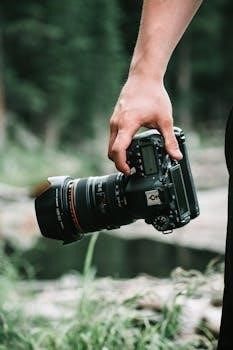Nikon D500 Instruction Manual⁚ A Comprehensive Guide
Unlock the full potential of your Nikon D500 with this comprehensive guide! Far surpassing the standard user manual, this guide offers detailed instructions, helpful tips, and expert insights. Master every feature, setting, and control of this powerful DX-format camera, and elevate your photography skills.
The Nikon D500 is a feature-rich, high-performance DSLR camera designed for both photographers and videographers. Boasting a 20.9 MP CMOS sensor, the D500 delivers exceptional image quality and detail. This camera combines advanced technology with user-friendly controls, making it suitable for both experienced professionals and enthusiastic amateurs looking to enhance their skills.
Connectivity options include Wi-Fi, NFC, and Bluetooth, allowing for seamless image transfer and remote control. The D500 also features dual memory card slots, providing ample storage and backup options. Its robust build quality ensures reliability in various shooting conditions.
This guide aims to provide a comprehensive introduction to the Nikon D500, exploring its key features, settings, and functions. Whether you’re a beginner or a seasoned photographer, this manual will help you master the D500 and unlock its full creative potential. You can find the official Nikon D500 manual on the Nikon website for download.
Understanding the Camera Modes⁚ P, S, A, and M
The Nikon D500 offers four primary shooting modes⁚ P (Program Auto), S (Shutter Priority), A (Aperture Priority), and M (Manual). Each mode provides a different level of control over the camera’s settings, allowing you to adapt to various shooting scenarios.
P (Program Auto)⁚ In this mode, the camera automatically selects both the aperture and shutter speed for optimal exposure. You can still adjust other settings like ISO and white balance.
S (Shutter Priority)⁚ You choose the shutter speed, and the camera automatically selects the appropriate aperture. This is ideal for capturing motion or controlling blur.
A (Aperture Priority)⁚ You choose the aperture, and the camera selects the shutter speed. This mode is useful for controlling depth of field.
M (Manual)⁚ You have complete control over both the aperture and shutter speed. This mode offers the most creative flexibility but requires a good understanding of exposure.
Mastering these modes is crucial for getting the most out of your Nikon D500, allowing you to capture stunning images in any situation.

Navigating the Mode Button
Unlike some Nikon cameras with a physical mode dial, the D500 utilizes a mode button for selecting shooting modes. This button, typically located on the top of the camera, provides access to the P, S, A, and M modes, along with other settings.
To change the shooting mode, press and hold the MODE button with your left hand. While holding the button, rotate the rear command dial with your right hand. As you rotate the dial, the available shooting modes will appear in the camera’s viewfinder or on the LCD screen.
Continue rotating the dial until your desired mode is highlighted, then release the MODE button. The camera will now be set to the selected shooting mode.
This system might feel different initially compared to a traditional mode dial, but it quickly becomes intuitive with practice. Familiarizing yourself with the location and function of the MODE button is essential for efficient operation of the Nikon D500 and swiftly adapting to changing shooting conditions.
Manual Mode⁚ Auto ISO and Exposure Compensation

In Manual (M) mode on the Nikon D500, you have full control over both aperture and shutter speed. However, you can still leverage Auto ISO to simplify exposure in changing light conditions. With Auto ISO enabled in M mode, the camera automatically adjusts the ISO sensitivity to achieve proper exposure based on your chosen aperture and shutter speed.
Exposure compensation is typically associated with Aperture Priority (A) or Shutter Priority (S) modes, but its relevance in Manual mode, especially with Auto ISO, is a common question. While you directly control aperture and shutter speed in M mode, exposure compensation can still influence the Auto ISO behavior.
In this scenario, exposure compensation acts as a bias, telling the camera to favor brighter or darker exposures when determining the Auto ISO value. For instance, if you set a positive exposure compensation, the camera will aim for a brighter image by selecting a lower ISO value (or maintaining a lower ISO for longer) than it would without the compensation.
Experimenting with Auto ISO and exposure compensation in Manual mode allows you to fine-tune your images and maintain creative control while adapting to varying lighting situations.
Key Features of the Nikon D500
The Nikon D500 is a feature-rich, high-performance DSLR designed for serious photographers and videographers. At its heart is a 20.9MP CMOS sensor, delivering exceptional image quality with impressive detail and dynamic range. Its advanced autofocus system, featuring 153 focus points, ensures sharp and accurate focus, even when tracking fast-moving subjects.
The D500 boasts a rapid continuous shooting speed of up to 10 frames per second, making it ideal for capturing action shots and wildlife. Its robust build quality and weather-sealing provide durability in challenging environments. The camera offers 4K UHD video recording capabilities, allowing you to create stunning, high-resolution videos.
Connectivity options include built-in Wi-Fi, NFC, and Bluetooth, enabling seamless image transfer and remote camera control via a smartphone or tablet. The D500 also features dual memory card slots, offering flexibility for storage and backup. Its intuitive interface and customizable controls provide a user-friendly experience for photographers of all levels.
These features combine to make the Nikon D500 a versatile and powerful tool for capturing exceptional images and videos in a wide range of shooting scenarios.
Custom Settings and Controls
The Nikon D500 offers a wealth of custom settings and controls, allowing photographers to tailor the camera to their specific needs and shooting styles. The extensive customization options provide a personalized shooting experience, enhancing efficiency and creativity.
Custom control assignments allow users to remap various buttons and dials to perform specific functions, such as focus-related tasks, exposure compensation, or ISO adjustments. This enables quick access to frequently used settings without navigating through menus.
The D500’s menu system is highly customizable, with options to adjust numerous parameters, including autofocus behavior, metering modes, and image processing settings. Custom setting banks allow users to save and recall different configurations for various shooting scenarios.
Furthermore, the camera offers advanced features like focus peaking and zebra stripes for precise manual focusing and exposure control during video recording. The customizable “My Menu” option provides quick access to frequently used menu items, streamlining the shooting process.
By exploring and utilizing these custom settings and controls, photographers can optimize the Nikon D500 to perfectly match their individual preferences and maximize their creative potential.
Firmware Updates for Nikon D500
Keeping your Nikon D500’s firmware up to date is essential for optimal performance, bug fixes, and access to new features. Nikon regularly releases firmware updates to enhance camera functionality and address potential issues.
To check your current firmware version, navigate to the setup menu on your camera. The firmware version will be listed under “Firmware version.” It is recommended to visit the official Nikon website periodically to check for available updates.
The update process generally involves downloading the latest firmware file from Nikon’s website and copying it to a memory card. Ensure the memory card is formatted in the camera before copying the file.
Insert the memory card into the camera and follow the instructions in the camera’s setup menu to initiate the firmware update. It is crucial to ensure that the camera’s battery is fully charged or connected to a power source during the update process to prevent interruptions.
Never turn off the camera or remove the battery during the update, as this could cause serious damage. After the update is complete, verify the new firmware version in the setup menu. Staying current with firmware updates helps ensure your Nikon D500 operates at its best.
Downloading the User Manual
Accessing the Nikon D500 user manual is straightforward and essential for understanding the camera’s full capabilities. The manual is readily available as a free PDF download from the official Nikon website. This digital format allows for easy access on various devices, including computers, tablets, and smartphones.
To download the manual, navigate to Nikon’s Download Center and search for the Nikon D500. From there, you’ll find various resources, including the user manual in multiple languages. Select your preferred language and click the download link.
Before downloading, review the download terms and conditions provided by Nikon. These terms outline the legal agreement between you and Nikon regarding the use of the manual.

The PDF manual provides comprehensive information on all camera functions, settings, and troubleshooting tips. It’s a valuable resource for both new and experienced D500 users. Keeping a copy of the manual on your devices ensures that you can quickly reference it whenever you have questions about your camera.
Additionally, Nikon often provides addendums or supplementary guides for specific firmware updates or features. Be sure to check for these resources alongside the main user manual.
Exploring Camera Functions
The Nikon D500 is a feature-rich camera, offering a wide array of functions to cater to various photographic needs. Understanding these functions is key to maximizing the camera’s potential and capturing stunning images.
Delve into the D500’s menu system to discover options for image quality, white balance, ISO settings, and more. Experiment with different settings to see how they impact your photos. For example, explore the Active D-Lighting feature to enhance dynamic range in high-contrast scenes, or adjust the Picture Control settings to fine-tune the color and tone of your images.
The D500 also offers advanced features like focus peaking for manual focusing, highlight-weighted metering for preventing overexposure, and interval timer shooting for creating time-lapse videos. Consult the user manual for detailed instructions on how to use these functions.
Furthermore, explore the camera’s video capabilities, including its support for multiple video resolutions and frame rates. Learn how to adjust audio levels, use external microphones, and take advantage of the D500’s advanced video recording features.
By thoroughly exploring the camera’s functions, you’ll gain a deeper understanding of its capabilities and be able to capture the images you envision.
Useful Camera Controls
The Nikon D500 boasts an array of physical controls designed for efficient and intuitive operation. Mastering these controls is crucial for quickly adjusting settings and capturing fleeting moments.
Familiarize yourself with the placement and function of the various dials, buttons, and switches. The mode dial allows you to select different shooting modes, while the command dials control aperture, shutter speed, and other parameters. The multi-selector enables you to navigate menus and select focus points.
Learn how to customize the function buttons to access frequently used settings with ease. For example, you can assign the ISO setting to a button for quick adjustments in changing lighting conditions. Also, understand how the autofocus system works, and experiment with different focus modes and focus area modes to achieve sharp focus in various situations.

Explore the D500’s viewfinder display, which provides essential information such as exposure settings, focus points, and battery level. Learn how to interpret this information and use it to make informed decisions about your shots.
By becoming proficient with the camera’s controls, you’ll be able to react quickly to changing situations and capture stunning images with confidence.
Troubleshooting and FAQs
Even with a well-designed camera like the Nikon D500, occasional issues may arise. This section provides solutions to common problems and answers frequently asked questions to help you get back to shooting quickly.
If your images appear blurry, double-check your focus settings and ensure that you are using a sufficiently fast shutter speed to avoid camera shake. Also, inspect your lens for any smudges or dirt that may be affecting image quality.
Encountering error messages? Consult the camera’s manual or Nikon’s support website for explanations and troubleshooting steps. Common error messages relate to memory card issues, battery problems, or lens compatibility.
Experiencing difficulty with autofocus? Ensure that you have selected the appropriate focus mode and focus area mode for your subject. Also, check that your lens is properly attached and clean.
Having trouble connecting to Wi-Fi or Bluetooth? Verify that your camera and smart device are both compatible and that you have followed the correct pairing procedure.
If you are unable to resolve an issue on your own, consider contacting Nikon’s customer support for assistance. They can provide expert guidance and help you diagnose and fix any problems you may be experiencing.
Available Resources⁚ eBooks and Guides
Beyond the official Nikon D500 user manual, a wealth of resources are available to deepen your understanding and mastery of this exceptional camera. eBooks and guides offer expanded explanations, practical tips, and creative inspiration, catering to photographers of all levels.
Consider exploring comprehensive guides like “Mastering the Nikon D500” by Darrell Young, which delves into the camera’s features and capabilities with experience-based insights. David Busch’s guides are also highly recommended for their clear explanations and practical advice.
For a more hands-on learning experience, look for eBooks that provide step-by-step tutorials and real-world examples. These resources often cover specific shooting scenarios, such as landscape photography, portraiture, or action photography.
Online forums and communities dedicated to Nikon photography can also be valuable sources of information. Engage with fellow D500 users, ask questions, and share your experiences to learn from others.
Remember to check for updated resources periodically, as firmware updates and new techniques may emerge over time. Staying informed will help you maximize your D500’s potential and continue to grow as a photographer.
Whether you prefer a printed guide or a digital eBook, investing in additional resources can significantly enhance your Nikon D500 experience.
Additional Accessories and Support
To further enhance your Nikon D500 experience, consider exploring a range of accessories designed to optimize performance and expand creative possibilities. From lenses to lighting equipment, the right accessories can significantly impact your photography.
Investing in high-quality lenses is crucial for capturing sharp, detailed images. Explore Nikon’s extensive lineup of NIKKOR lenses, including wide-angle, telephoto, and prime options, to suit your specific shooting needs. Don’t forget to consider filters to protect your lenses and enhance image quality.
External flashes and speedlights can provide additional lighting control, allowing you to illuminate your subjects effectively in various situations. Experiment with different lighting techniques to create dramatic effects and enhance your portraits or product shots.
Memory cards are essential for storing your photos and videos. Choose cards with sufficient capacity and fast write speeds to ensure smooth performance, especially when shooting in continuous mode or recording high-resolution videos.
Battery grips can extend your camera’s battery life and provide a more comfortable grip, especially when using heavy lenses. Consider a remote shutter release for minimizing camera shake during long exposures or time-lapse photography.
Nikon offers excellent customer support through its website, phone lines, and authorized service centers. If you encounter any issues or have questions about your D500, don’t hesitate to reach out for assistance. Regularly check for firmware updates to ensure optimal performance and compatibility.
